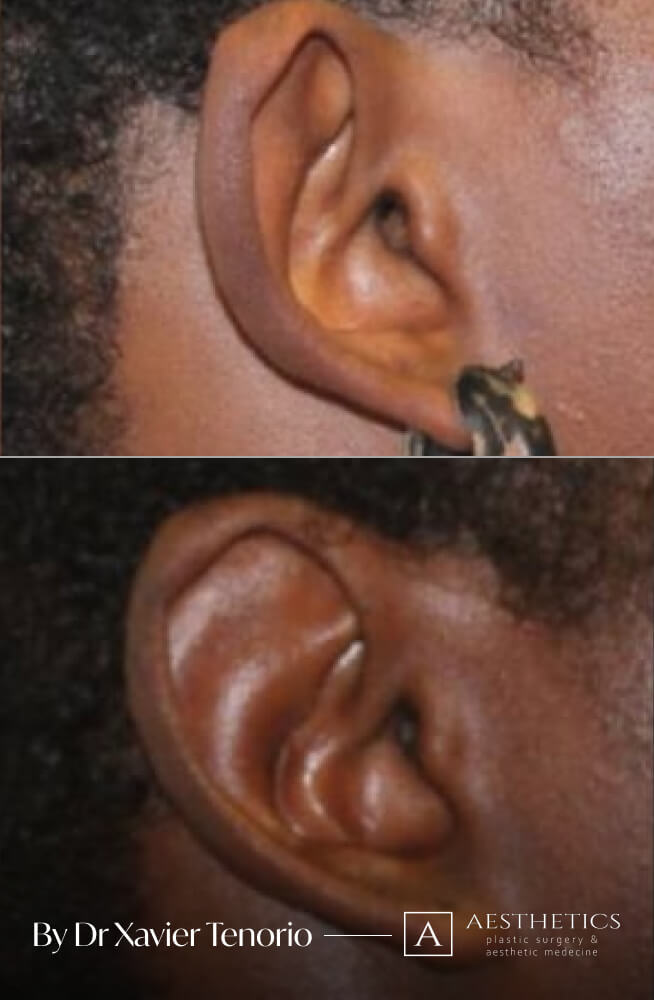The result for our customers
Book a FREE 3D consultation and we will show you results from our clients that are close to your personal case
To book your consultation or find out detailed prices, please fill out the form
About prominent ears
Correcting protruding ears requires a surgical procedure, called “otoplasty,” which aims to rearrange the cartilages considered to make the ear excessively visible. The operation is usually performed on both ears, but can sometimes be unilateral.
There are schematically three types of ear malformations, which are often more or less associated with each other: The skin is then lifted in order to reach the cartilage then the cartilages are remodeled by certain small incisions and sutures in certain cases the sutures on the skin must be removed 10 days after the operation.
It is done with elastics around the head to keep the ears in the correct position. Depending on the surgeon and the importance of the malformations to be corrected, a bilateral otoplasty can last around two hours in total. The pain is generally moderate and, if necessary, treated with analgesics for a few days.
A follow-up consultation with the surgeon is essential. The first large dressing will be removed between the second and fifth postoperative day. It will then be replaced by a lighter dressing for a few days. The ears will appear swollen, which is normal, a transitional period that does not compromise the final result. As a safety measure, you are asked to wear an elastic (tennis band) day and night for two weeks, then only at night for a few days. During this period, physical and sporting activities with risk of contact should be avoided.
Exposure to cold is not recommended for at least two months. The result can be fully appreciated from the second month post-operatively. At this stage, the tissues are more flexible and the edema (swelling) has resolved. At the end of this period, only the scars will still be a little marked. This surgery corrects anomalies and obtains symmetrical, natural and harmonious ears. In the vast majority of cases, the results are definitive.
However, a recurrence may possibly occur in the medium term, which may then require a small correction.
Plastic surgery
This procedure is normally carried out under local anesthesia, but if general anesthesia is necessary, an appointment with the anesthetist will be made at least 48 hours before the procedure. Medications containing aspirin must be stopped 10 days before the procedure. ‘intervention. For boys, a fairly short haircut is desirable. For girls, a ponytail will be enough. The head and hair should be washed thoroughly the day before the operation. Depending on the type of anesthesia, it may be necessary to avoid drinking or eating 6 hours before the operation. An otoplasty, although simple and performed mainly for aesthetic reasons, is nonetheless a surgical procedure, which carries the same risks as other surgical procedures. Although extremely rare, complications related to anesthesia must be distinguished from those related to the procedure. Regarding anesthesia, the anesthesiologist explains the risks and answers the patient’s questions during a preoperative consultation. Current technology makes it possible to practice anesthesia in the best safety conditions for the patient and the surgical team. Regarding the surgical procedure: choosing a qualified surgeon minimizes any risk. Fortunately, serious complications are very rare and patients are fully satisfied with their result. However, possible complications are: Postoperative bleeding, the formation of hecatombs which often have to be evacuated, infection (very rare), skin necrosis secondary to circulation disorders on very thin skin and scar abnormalities.
First consultation
with 3D simulation
in Geneva, Gstaad and Montreux
Fill out the form to request the free consultation
Go to formFirst consultation
with 3D simulation
in Geneva, Gstaad and Montreux
First consultation
with 3D simulation
in Geneva, Gstaad and Montreux!
Fill out the form to request the free consultation
Go to FormProminent Ears & Methods of Treatment.

Otoplasty
Bandage
It is done with elastics around the head to keep the ears in the correct position.
Working time
Depending on the surgeon and the importance of the malformations to be corrected, a bilateral otoplasty can last around two hours in total.
Result
The result can be fully appreciated from the second month post-operatively. At this stage, the tissues are more flexible and the edema (swelling) has resolved. At the end of this period, only the scars will still be a little marked.
Type of anesthesia and hospitalization
Three options are possible;
- Pure local anesthesia, where an analgesic product is injected locally to ensure insensitivity to the ears.
- Local anesthesia deepened by a relaxant.
- Traditional general anesthesia. The choice between these different techniques will result from a discussion between you, the surgeon and the anesthesiologist.
Hospitalization: Usually, the operation is carried out on an “ambulatory” basis, that is to say the patient leaves the same day after a few hours of monitoring. However, in certain cases, a short hospitalization may be preferred.













